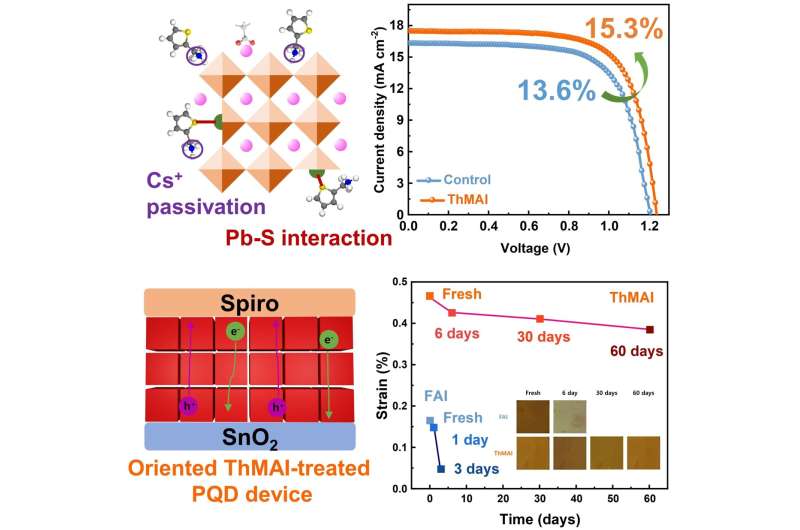
October 4, 2024 by DGIST (Daegu Gyeongbuk Institute of Science and Technology)
Collected at: https://techxplore.com/news/2024-10-scientists-quantum-dot-solar-cells.html
Researchers have developed a new method to improve both the performance and the stability of solar cells using “perovskite quantum dots.” They developed longer-lasting solar cells by addressing the issue of distortions on the surface of quantum dots, which deteriorate the performance of solar cells.
Professor Jongmin Choi’s team from the Department of Energy Science and Engineering at DGIST conducted the research with Materials Engineering and Convergence Technology Professor Tae Kyung Lee from Gyeongsang National University and Applied Chemistry Professor Younghoon Kim from Kookmin University.
The findings were published in the Chemical Engineering Journal on September 15, 2024.
Perovskite quantum dots are critical materials for next-generation solar cells. They have excellent light-to-electricity conversion capabilities and are easy to mass-produce. However, to utilize them in solar cells, the “ligands” attached to the quantum dot surface must be replaced. This process often leads to distortions of the quantum dot surface, resembling crumpled paper, which results in decreased performance and shorter lifespans for the solar cells.
To address this issue, Professor Jongmin Choi’s team newly adopted short ligands that securely hold the quantum dots from both sides, effectively uncrumpling the distorted surface.
The ligands help restore the distorted lattice structure, smoothing the crumpled surface of the quantum dots. This significantly reduces surface defects, enabling the solar cells to operate more efficiently and extending their lifespan.
Consequently, the power conversion efficiency of the solar cells increased from 13.6% to 15.3%, demonstrating stability by maintaining 83% of their performance for 15 days.
“Through this research, we could minimize surface defects on the quantum dots and stabilize their surfaces by newly adopting these amphiphilic ligands, thereby significantly improving the efficiency and stability of the solar cells,” said Professor Jongmin Choi from the Department of Energy Science and Engineering at DGIST.
“We plan to continue our research on stabilizing the surface of perovskite quantum dots, hopefully applying the results to various photoelectric devices.”
More information: Gayoung Seo et al, Multifaceted anchoring ligands for uniform orientation and enhanced cubic-phase stability of perovskite quantum dots, Chemical Engineering Journal (2024). DOI: 10.1016/j.cej.2024.154312
Journal information: Chemical Engineering Journal

Leave a Reply